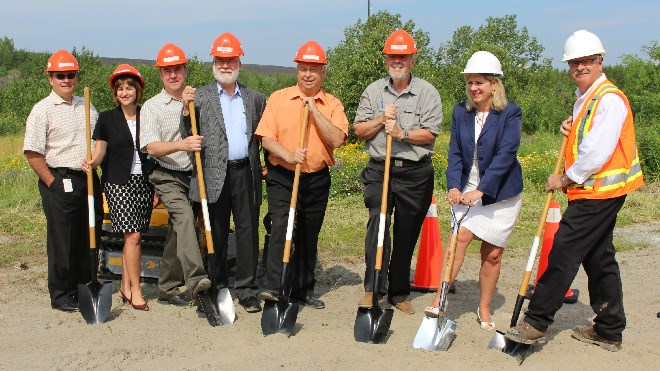The scent in the air at the Kelly Lake Road wastewater treatment plant Thursday morning was all the explanation anyone could want about why the city is spending $63 million on a biosolids plant.
The earthly smells that greeted reporters attending the official groundbreaking ceremony were mild compared to the odours that have plagued residents in Lively for years. For more than three decades, the city dumped treated sludge into Vale's tailing pond in that community. But growing odour problems led to more complaints from residents, and a few years ago, Vale told the city it would have to find another solution. The province also passed tougher environmental legislation, forcing the city's hand.
In November, city council approved a public-private sector partnership to build the facility. A private firm – N-Viro, a Canadian company -- will build and operate the plant for 20 years, in exchange for an annual operating payment of $2.8 million and an agreement to finance the debt on 75 per cent of construction costs.
The federal government is providing $11 million through PPP Canada, a Crown corporation created in 2009 to administer a $1.2 billion fund aimed at encouraging public-private partnerships to build facilities like the biosolids plant.
Tony Cecutti, the city's general manager of infrastructure, said the plant is a first on a couple of fronts.
“It's the first (P3 project) for the City of Greater Sudbury and the first for a biosolids plant in Canada,” Cecutti said. “We're excited to be part of this project moving forward.”
Greater Sudbury Mayor Marianne Matichuk put it this way: “A biosolids plant is something nobody really wants, but is something Greater Sudbury clearly needs.
“We can't keep dumping our problems in someone's back yard.”
She thanked staff for their work on what has been a long and complicated process, singling out Ward 2 Coun. Jacques Barbeau and Ward 1 Coun. Joe Cimino, who played a significant role. Once complete in two years, the plant will be capable of extracting nutrients for mulch and soil from the waste, rather than just dumping it all in a pond.
“This project is keeping Greater Sudbury at the forefront of the environmental sustainability movement in Canada,” Matichuk said.
Ward 5 Coun. Ron Dupuis, speaking on behalf of Cimino and Barbeau, said it's important to remember the plant will help residents of Lively who were forced to put up with “atrocious” smells emanating from the tailings pond.
“This was a major, major problem,” Dupuis said. “It is definitely needed.”
Greg Clausen, Cecutti's predecessor who retired a year ago, said the biosolids facility is the culmination of efforts that began in earnest in 2005. Getting to this stage took a long time, Clausen said, because the city was dealing with several stakeholders -- the federal government, the province and Vale.
“So many people have spent so many hours working on this,” Clausen said.
Rob Sampson, president of N-Viro, said he's “tickled pink” to be part of an all-Canadian solution to Greater Sudbury's biosolids problem. The company, which now operates six plants in Canada, will use technology developed here to extract nutrients from the sludge.
“We can no longer be dumping our organic waste into the landfill,” Sampson said. “N-Viro is committed to recovering and reusing nutrients found in our organic waste streams.
“We're happy to be your partner in the solution. And the solution starts with the turning of the sod today.”
Using heat and chemicals, pathogens in the sludge are killed during the treatment process, then nutrients and water are separated. The company is responsible for finding buyers for the organic nutrients it produces, and for hauling it away.
Once complete, the plant will treat about 15,000 tonnes of biosolids a year, creating 30,000 tonnes of a nutrient-rich compound known as N-Rich.
Join Sudbury.com+
- Messages
- Post a Listing
- Your Listings
- Your Profile
- Your Subscriptions
- Your Likes
- Your Business
- Support Local News
- Payment History
Sudbury.com+ members
Already a +member?
Not a +member?
Sign up for a Sudbury.com+ account for instant access to upcoming contests, local offers, auctions and so much more.
